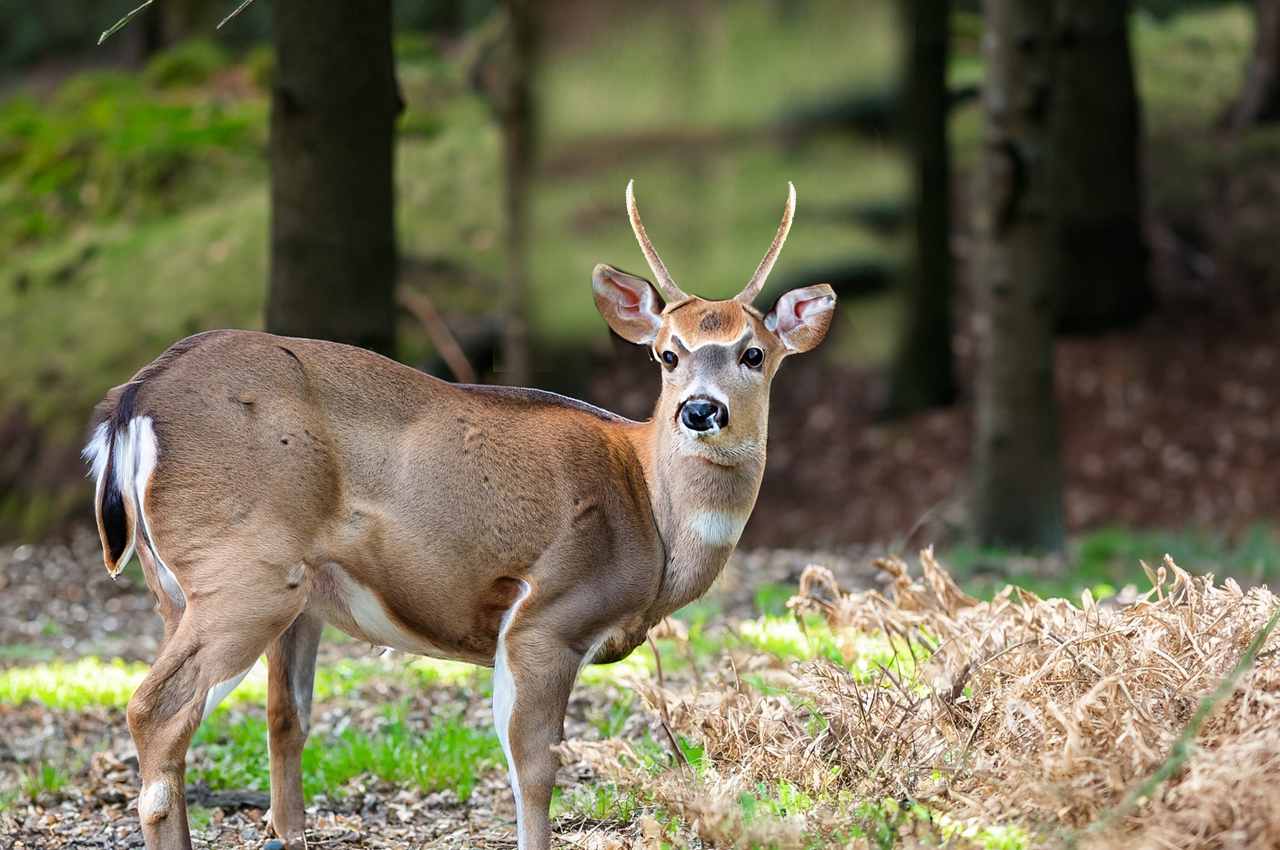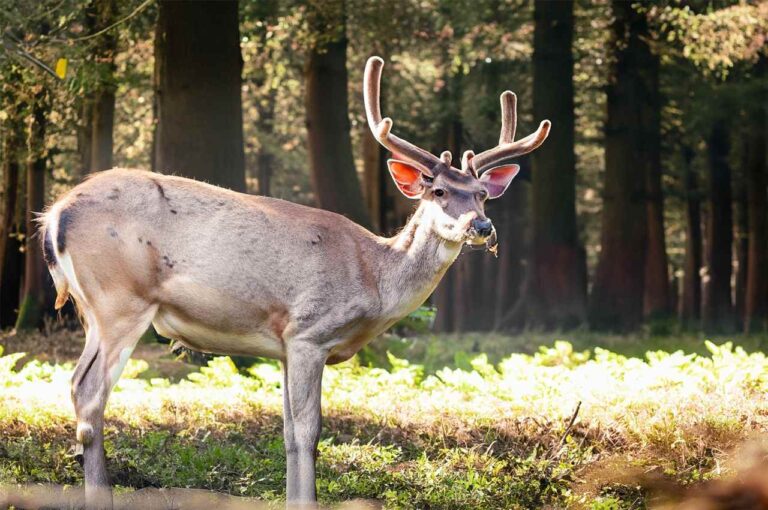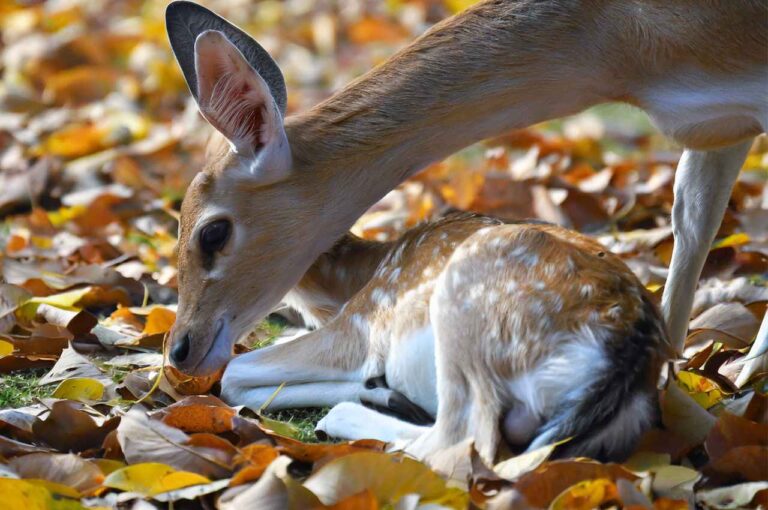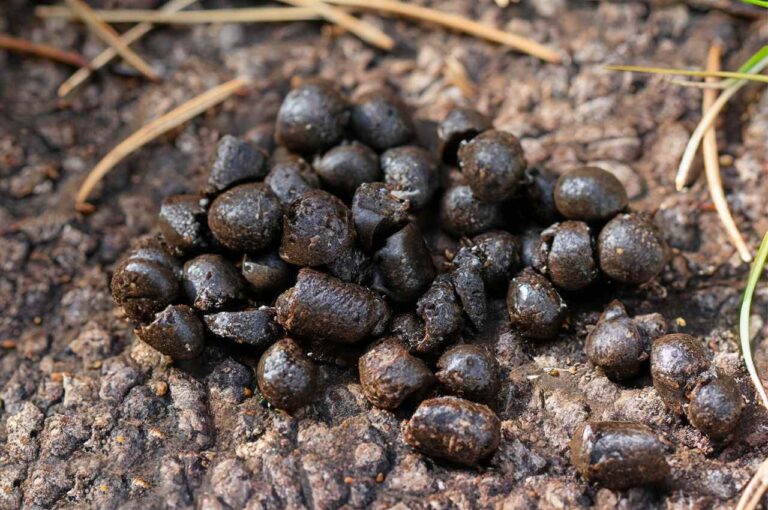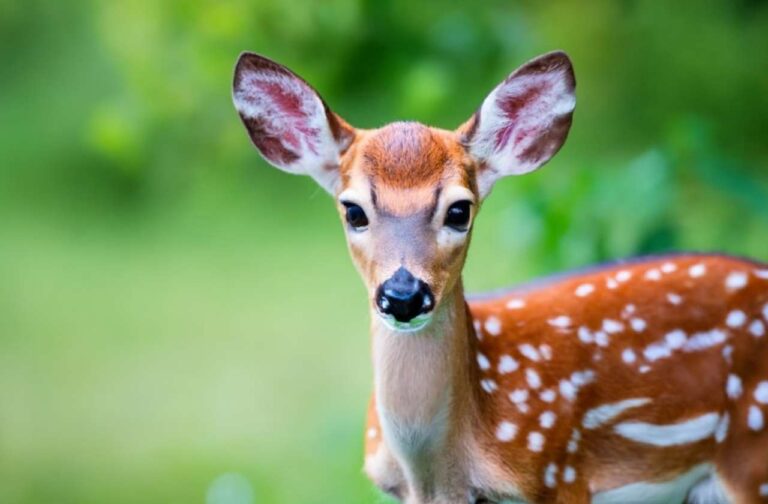What Is A Spike Buck: When, Where, and Why They Appear!
So, what is a spike buck like to encounter in the wild? Well, it often resembles a doe from a distance due to its unbranched antlers and generally a deer between 1.5 to 2.5 years old. Although “spike buck” is a widespread name among hunters and wildlife lovers, it is less well known what makes a deer turn into a spike buck. Spike bucks will be discussed in further detail on this page, including their characteristics, the origin of their distinctive antlers, and if they need to be eliminated from the breeding population.
What is a spike buck?
When a male deer has unbranched antlers and is at least 1.5 years old, the male is referred to as a “spike buck.” Typically, spike bucks are yearlings, although they may sometimes be older males with immature antlers.
Numerous factors might cause a buck to develop spike antlers. The buck may not have had enough time to grow adult antlers, which is one explanation. Another explanation is that the buck could have had stress or a dietary shortage that prevented antler development.
Spike bucks are often pursued by hunters seeking a challenge. Since spike bucks are sometimes more suspicious and elusive than adult bucks, they may be challenging to hunt. Spike bucks, though, may also be an excellent supply of meat and antlers.
Here are some of the characteristics of spike bucks:
| Characteristic | Description |
|---|---|
| Antler Shape | Slender, unbranched spikes on both sides |
| Antler Length | Typically less than 20 inches |
| Antler Tips | Often curved inward toward the head |
| Body Size | Smaller than mature bucks |
| Neck & Build | Lacks thick neck and stocky build |
A key component of the deer population might be spike bucks. They compete with older bucks for food and females, which helps to regulate the deer population. For hunters, spike bucks are a source of meat and antlers.

Prevalence of Spike Bucks by Season
| Season | Spike Prevalence | Reason |
|---|---|---|
| Early Fall | High | Yearling bucks growing first set of spikes |
| Winter | Low | Spikes shed in early winter |
| Late Winter | Increasing | Some late-born bucks retain spikes |
| Spring | High | Late-born spikes from previous year |
| Summer | Low | Spikes shed in late spring |
Typical Ages of Spike Bucks
Spike bucks typically range in age from 1.5 to 2.5 years. Their antlers have developed through the button stage but have not yet fully matured and begun branching at this age.
Age has a substantial correlation with deer antler growth. Each year a buck develops, his antlers often become bigger and more elaborate. Spike antlers are an early stage of this development. Although older bucks with spike antlers are feasible, they are less prevalent beyond 2.5 years of age.
| Age | Antler Development Stage |
|---|---|
| 0-12 months | Button buck (no antlers) |
| 12-18 months | Pedicles and velvet antler growth |
| 18-24 months | Spike antlers emerge |
| 24-42 months | Forked antlers develop |
| 42+ months | Full maturity reached |
Are spike bucks bad genetics?
No, spike bucks do not necessarily indicate bad genetics. There are a few key points to understand:
- The greatest potential for antler growth is determined by genetics, but environmental conditions also play a part in realizing that potential.
- For their antlers to completely grow and reflect their genetic potential, young bucks require appropriate nourishment and time.
- Before their antlers grow, 1.5 to 2.5 year old bucks may exhibit spikes, which is typical and anticipated. They do not have inferior genetics because of this transitory period.
- Even for bulls with good genetics, injuries, a late birth date, stress, etc., might impede antler development and cause spikes.
- Removing young males with the potential for huge antlers before they have had a chance to grow runs the danger of culling spikes.
- Deer should not be eliminated solely based on antler characteristics.
- Improving habitat and herd nutrition are more successful at producing deer with greater antlers than culling spikes.
So while spikes may indicate slower antler growth, they are not a definitive sign of bad genetics. Before presuming poorer genetics based on temporary spikes, young bucks should be given enough time and space to realize their full potential.
When does Spike Buck Appear?
Spike bucks thus tend to be more active in the early fall, just before the rut, and in the late winter and early spring after antler drop. As yearlings develop into bigger forked antlers, the population numbers decrease. Hence they are most prevalent at two peak times:
Fall Spikes:
- Yearling bucks, who are around 18 months old and developing their first set of antlers, start to show spike antlers in the beginning of fall.
- As the yearlings make the transition to forked antlers, these spikes shed in late fall or early winter.
- Since hunting seasons coincide with the peak autumn spike frequency, hunters may notice more spikes in the fields.
Spikes Bucks in spring:
- Some late-born bucks from the previous breeding season keep their spike antlers through the winter and into the next spring.
- These spikes, which are 18 to 20 months old, shed in the late spring.
- Late snow melts might prolong the spike antlers’ retention throughout the first part of the summer.
- Spring spikes are often the slower-maturing late-born bucks from the previous year.
In short, the spike buck population reaches its peak in the early autumn when yearlings develop their first spikes and then again in the late winter/early spring as retained spikes shed. As antlers are lost in the late autumn and winter and as new forked antlers form in the summer, the predominance of spikes decreases. However, the autumn or spring hunting seasons, when spike buck populations are at their maximum, are when hunters are most likely to come across them. Hunters may determine whether they are lawful targets in these encounters by recognizing spikes.
What Causes Spike Antler Growth?
Deer may develop spike-shaped antlers rather than branching ones for a variety of reasons, including the following:
| Factor | Effect on Antler Growth |
|---|---|
| Genetics | Sets maximum antler size/branching potential |
| Nutrition | Affects ability to reach genetic potential |
| Injury | Can cause abnormal shapes or asymmetry |
| Late Birth | Slower initial antler development |
| Overcrowding | Causes social stress; impacts growth |
| Weather | Extreme cold or heat can impair growth |
Genetics is one of these aspects that is very significant. A buck may never develop huge antlers even under perfect circumstances if it lacks the genetic aptitude. For a juvenile buck to realize its full genetic antler potential, however, a healthy diet and little stress are still essential.
Differentiating Spike Bucks from Button Bucks
The absence of antler tines that branch off the main beam is the defining feature of a spike buck. A spike buck has antlers that resemble short spikes sticking out of its pedicles rather than a complicated, branching set of antlers.
True spike antlers contain firm bone tissue, unlike immature fawns that may have tiny lumps or pedicles where antlers would later form. Fawns do not have spike antlers; they have fuzzy pedicles.
A “button buck” is a male fawn that has not yet grown any hardened antlers; a “spike buck” is distinct from this. Spike bucks have advanced through the button stage and are now developing complete antlers, albeit they do not yet have branches.
The Debate: Should Spike Bucks Be Culled?
Wildlife officials disagree on whether or not to remove spike bucks from the herd. Some claim that eliminating young males with poor antlers enhances a herd’s genetic potential. Others think spike bucks should grow before their genetics are evaluated.
Those who support the culling of spike bucks provide the following justification:
- Spikes show slower antler growth and worse genetics
- Removing spikes gives males with bigger antlers more opportunity to breed.
- Spike antler characteristics may be passed on to progeny.
Those that oppose the culling of spike bucks claim:
Spikes from late birth timing or damage don’t represent genuine genetic potential. Young bucks require time to physically grow and show their genetics. Nutrition and low stress also play important roles in antler development.
In general, wildlife scientists advise being cautious while removing spikes. It is better to focus on habitat improvement and herd nutrition than just culling. Before presuming spike bucks have inferior genetics, they need have time to grow.
Distinguishing Features of a Spike Buck
When trying to identify a spike buck, look for these characteristics:
- Slender, unbranched antlers on both sides
- Antler length typically less than 20 inches
- Antler tips often curved inward toward the head
- Overall smaller body size than older bucks
- Lacks the muscled neck and stocky build of a mature buck
On adult deer, spike antlers should be identified from damaged or wounded antlers. Spikes are symmetrical on both sides as opposed to being asymmetrical.
Are Spike Bucks Valuable as Trophy Hunters?
Spike bucks are often seen as less attractive than deer with bigger, more intricate antlers by trophy hunters and antler collectors. Spike antlers are thinner and less striking because they lack the branching tips that increase antler bulk.
However, because to their unusual form, spikes may still contribute something special to antler collections. Crafters who use shed antlers to make décor or jewelry may find smaller spike antlers appealing.
Spike antlers are of little interest to the meat hunter. A spike produces the same amount of deer meat as any other buck. However, because of its defensive nature, the majority of hunters avoid using shooting spikes.
The Outlook for Spike Bucks
Spike antlers are not very showy, but when juvenile bucks grow, they play a crucial developmental role. Spikes may ultimately develop into spectacular trophy racks with time and proper care.
Land managers should concentrate on enhancing habitat and decreasing herd stress rather than quickly eradicating spikes. Young bucks may now completely show their hereditary antler potential as they mature over the next several years.
That tiny spike buck might develop into the deer of a lifetime prize with enough time and nourishment. When it comes to controlling spike bucks, patience and caution are essential.
Frequently Asked Questions
What's the difference between a spike buck and a button buck?
The term “button buck” describes a male fawn without antlers. Button bucks only have a few tiny, rounded lumps on their forehead, which will later develop into antlers. A spike buck is an adult male deer, often 1.5 years or older, with antlers that have grown on both sides of its head and are thin, unbranched, and resemble spikes. A spike buck has developed its first set of genuine antlers, which have solidified into bone tissue, in contrast to a button buck, which lacks any hardened antlers. However, at this early age, their antlers are devoid of any branching tines.
At what age do buck fawns start growing spikes?
Around the age of 18 months, buck fawns often start to develop their first set of spike antlers. Prior to this, the velvet antlers and pedicles begin to develop at the age of 12 months. The spikes completely develop and solidify into bone tissue in around six months. So, by 18 to 24 months of age, the majority of bucks have their first set of spikes. Early in the winter, the spikes are lost, then they come back as forked antlers.
Can poor nutrition cause a mature buck to have spike antlers?
Any age of buck may have a delay in antler development due to poor nutrition. However, mature males older than 2.5 years are less likely to produce spike antlers owing to diet alone. As deer age, genetics becomes more important in determining antler size. Even though a buck’s hereditary antler potential might be limited by inadequate diet, older bucks who have already reached adulthood are less likely to develop genuine spikes than young bucks. In severe situations of malnutrition, there may be exceptions.
Why are spike bucks protected from hunting in many states?
Many governments forbid the harvesting of spikes since they are quite young, at 1.5–2.5 years old, and should be allowed to grow. Before being eliminated based merely on having spike antlers at a young age, wildlife managers want to make sure bucks have the opportunity to develop their antlers to their full potential. Additionally, spikes are not as popular as prize animals. Allowing them to develop contributes to the herd’s healthy age distribution.
Can an injury cause a mature buck's antlers to become a spike?
Yes, damage to the pedicles or to the adult buck’s antlers while they are still in the velvet stage might result in aberrant antler development. As a consequence, there will often be an asymmetry where one antler is stunted or malformed while the other one seems quite normal. If damage was the reason, the antlers on an adult deer would seem asymmetrical rather than completely matching spikes.
Does a spike count as a buck?
Spike bucks are physiologically male deer, but most hunters don’t consider them “bucks” since they’re still juveniles under 2.5 years old. Spikes have firm antlers, but their unbranched spikes suggest they need additional maturation. Many jurisdictions ban spike shooting to conserve animals and maximize their potential. Hunters may shoot spikes for any buck, but patience is essential. Spikes alone do not indicate faulty genetics; bigger antler genetics require nutrients and time to develop. Even those with magnificent antlers may go through a spike period at 18-24 months of age, thus spikes should not be removed for genetics. Spike antlers may grow into beautiful racks over 3-5 years. Thus, immature spikes should not be removed before they develop.
Is a spike buck a fawn?
Spike bucks are not fawns. A fawn is a deer under one year old without hardened antlers. Antlers sprout on male fawns’ pedicles. Spike bucks are older deer, usually 1.5 years or older, with their first set of thin, unbranched spike antlers. The key difference is that spike bucks have developed firm bone antlers, not pedicles like fawns. Although still young, a spike buck develops hardened spikes after passing the pedicle button stage. Thus, a spike buck has its first genuine antlers but no mature, branching ones.
Is it illegal to shoot a spike deer?
Shooting spike deer depends on state and local hunting laws. For example in Mississippi, spike deer are legal to shoot, however biologists advocate targeting 3-inch or smaller spikes. However, shooting a spike or forky buck in Ohio is unlawful if the minimum is three points. Wildlife managers try to improve deer populations by protecting spike bucks. Some states allow spike hunting with limited seasons or permission requirements. Therefore, hunters must examine state and local hunting laws to discover whether shooting a spike deer is lawful, controlled, or forbidden.
Why do people shoot spike bucks?
People kill spikes, or young male deer with unbranched antlers, for different reasons, however many localities restrict it owing to its possible harmful influence on deer populations and genetics. Hunters may be impatient and take any buck instead of letting young spikes evolve into bigger, better bucks. Others may kill spikes because they think they need to be culled for bad genetics, not comprehending that antler potential takes time and nutrients to mature. Misconceptions regarding trophy criteria or selling or making spike antlers may also motivate spike shooting. Spike poaching may be open in places with poor law enforcement. Traditions and family traditions supporting spike shooting may also impact these choices. Wildlife specialists recommend patience and spike buck conservation to preserve healthy herd demographics and genetics since spikes may grow into magnificent bucks with time and better circumstances.
Conclusion
Generally, spike bucks are between 1.5 to 2.5 years old. White-tailed deer spike bucks have a distinctive appearance, but this unbranched antler stage is only brief. Most spikes develop into bigger, forked antlers as bucks grow physically and genetically to their maximum capacity. Although spikes may not have much trophy value, they are crucial to a buck’s growth and development.
- Wyoming Deer Season 2025-2026 New Schedule & Rules - 15 September 2025
- Wisconsin Deer Season 2025-2026: WI Deer Hunting Guide [Schedule, Rules, Licenses] - 15 September 2025
- West Virginia Deer Season 2025-2026 Complete Date & Guide - 15 September 2025
